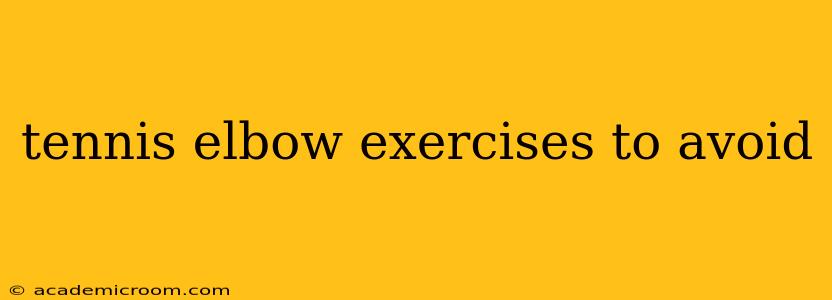Tennis elbow, or lateral epicondylitis, is a painful condition affecting the outside of the elbow. While exercise is crucial for recovery and strengthening, certain movements can exacerbate the condition, potentially delaying healing or even causing further damage. Understanding which exercises to avoid is just as important as knowing which ones to perform. This guide will highlight exercises to steer clear of if you're dealing with tennis elbow and explain why they're detrimental to your recovery. We'll also address some frequently asked questions surrounding tennis elbow exercises.
Why Certain Exercises Aggravate Tennis Elbow?
Tennis elbow stems from overuse and inflammation of the tendons that connect the forearm muscles to the lateral epicondyle (the bony bump on the outside of your elbow). Exercises that place excessive stress on these already inflamed tendons will worsen the pain and inflammation. This often involves repetitive movements, forceful gripping, or extreme wrist positions.
Exercises to Avoid with Tennis Elbow
Here are some exercises that should generally be avoided if you have tennis elbow:
1. Wrist Extensor Strengthening with Heavy Weights:
Exercises focusing on forceful wrist extension (bending your wrist backward) while using heavy weights directly strain the affected tendons. These include wrist curls with heavy dumbbells or resistance bands performed with excessive force. The goal isn't to lift heavy; it's to build strength gradually.
2. Hammer Curls with Heavy Weight:
While hammer curls work the forearm muscles, heavy weights during this exercise can overload the extensor muscles involved in tennis elbow, leading to increased pain and inflammation.
3. Reverse Wrist Curls with Heavy Weight:
Similar to wrist extensor strengthening, reverse wrist curls (palms facing up) with heavy weights put excessive strain on the affected tendons.
4. Forearm Pronation and Supination with Resistance:
These exercises involve rotating your forearm (pronation is turning your palm down, supination is turning your palm up). While important for overall forearm health, forceful resistance during these movements can irritate the affected tendons.
5. Grip Strengthening Exercises with Excessive Force:
Activities like squeezing a grip strengthener with maximal force directly stress the affected tendons. This might include using a hand gripper or engaging in activities like heavy-duty gardening or manual labor.
6. Activities Involving Repetitive Gripping and Wrist Extension:
These are the primary culprits in the first place! Avoid activities that involve repeated gripping and wrist extension until your symptoms have significantly reduced. This might include specific sports techniques, work tasks, or hobbies.
Frequently Asked Questions (FAQs)
What are some good alternative exercises for tennis elbow?
Gentle range-of-motion exercises, low-impact stretching, and isometric exercises (holding a position rather than moving) are usually recommended initially. Focus on exercises that gradually increase strength without excessive strain. Your physical therapist or doctor can provide a tailored exercise plan.
How long should I avoid these exercises?
This varies depending on the severity of your tennis elbow and your individual response to treatment. It's crucial to consult with a healthcare professional to determine when you can safely resume these activities. They might recommend modifications or alternatives.
Should I completely stop all exercise if I have tennis elbow?
No. Complete rest isn't usually advised. However, you should modify your activities to avoid exercises that aggravate your pain. Gentle, low-impact exercise, and proper stretching are often beneficial.
Conclusion: Listen to Your Body
Remember, the key is to listen to your body. If an exercise causes pain, stop immediately. It's essential to work with a physical therapist or other qualified healthcare professional to develop a tailored rehabilitation program that addresses your specific needs and avoids further injury. Proper diagnosis and guidance are crucial for effective recovery from tennis elbow. Ignoring pain signals can prolong recovery and increase the risk of long-term problems.
